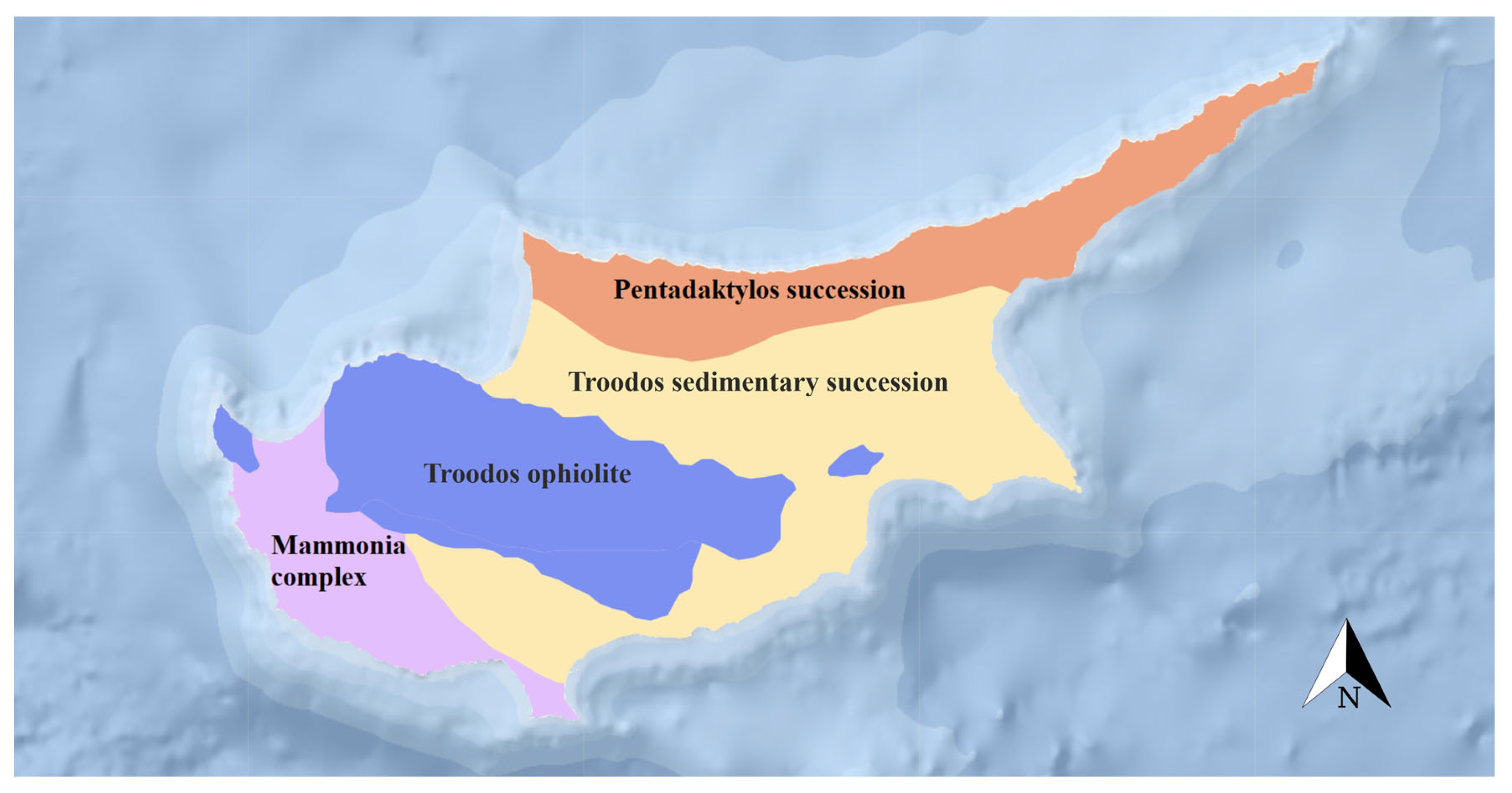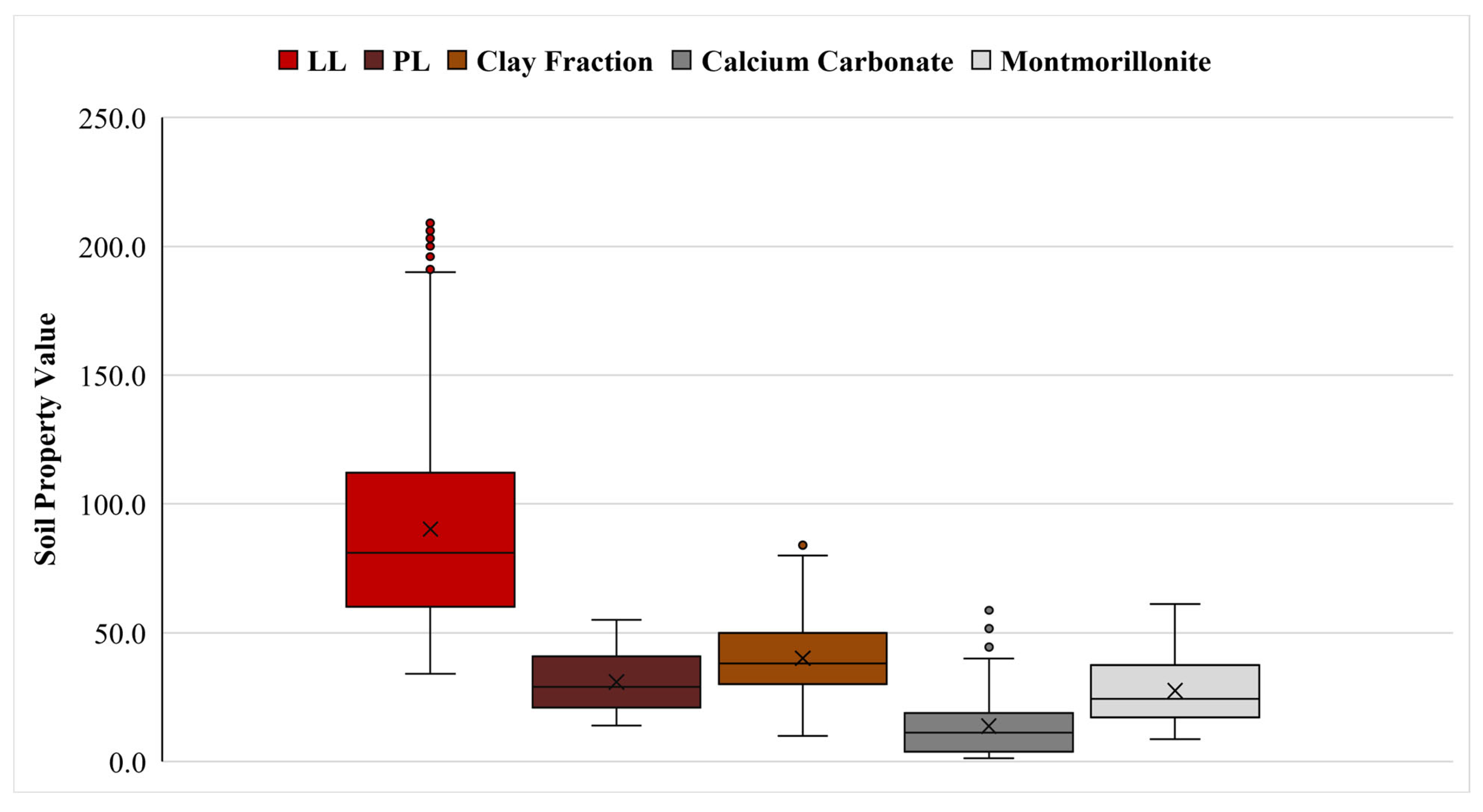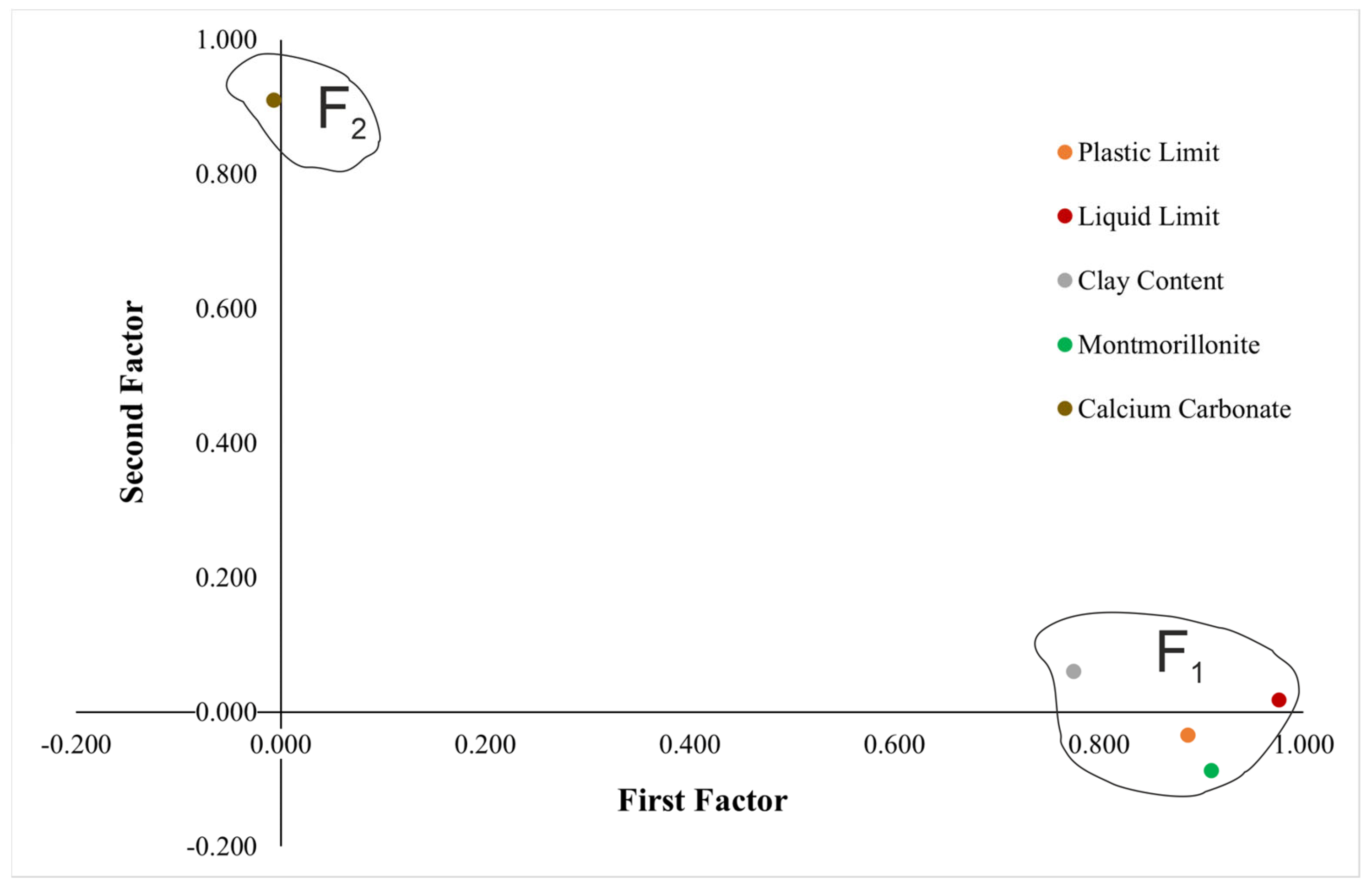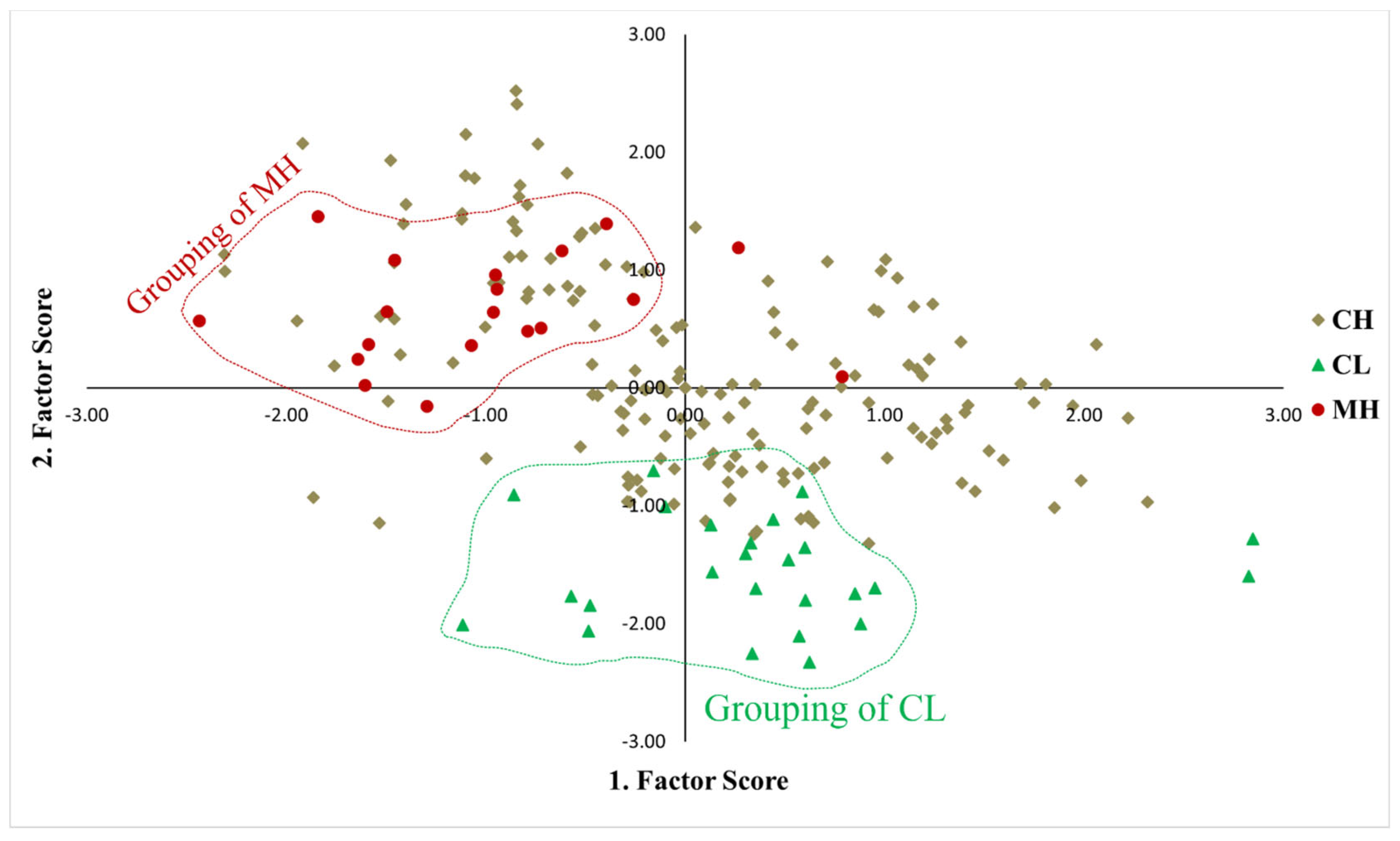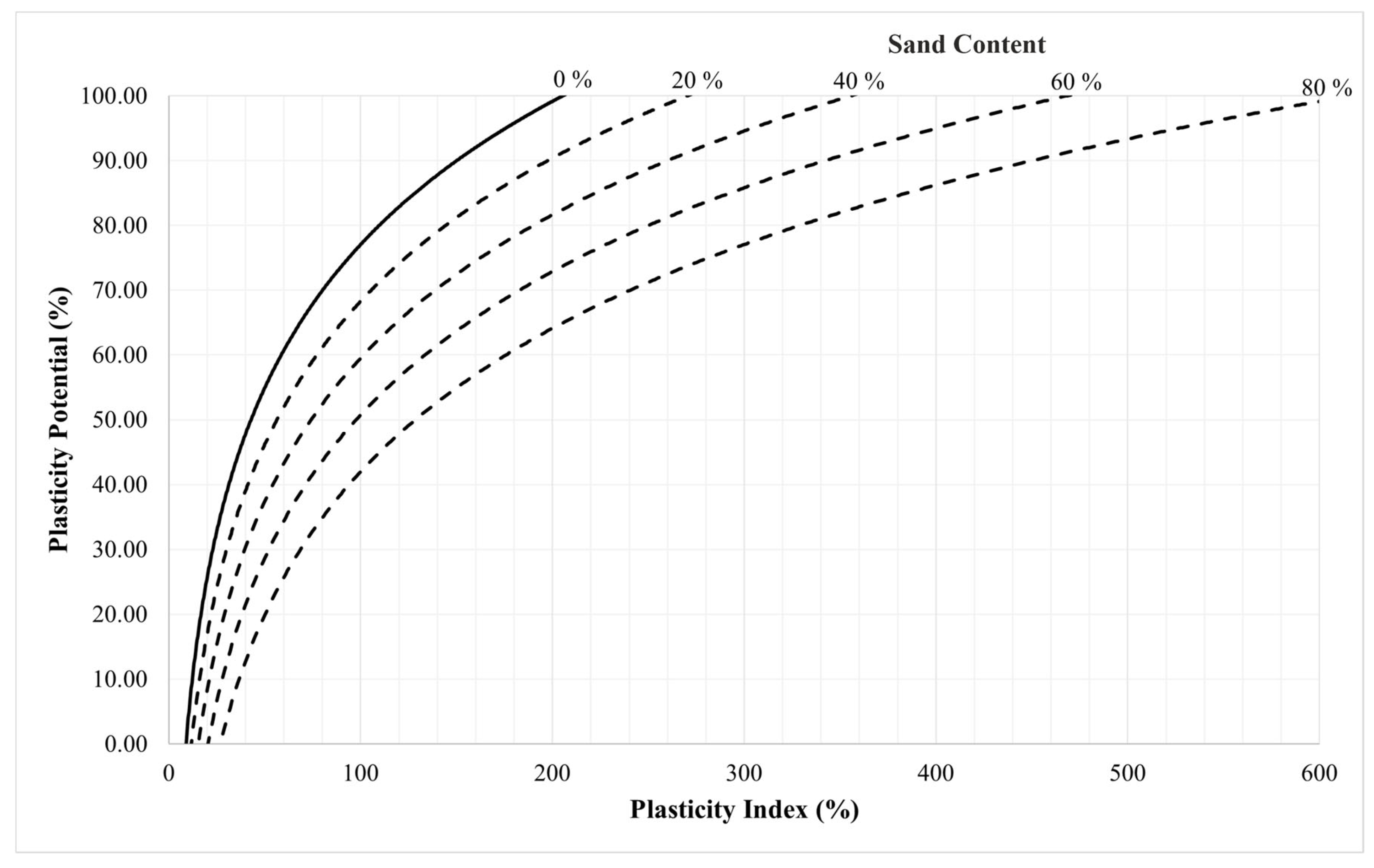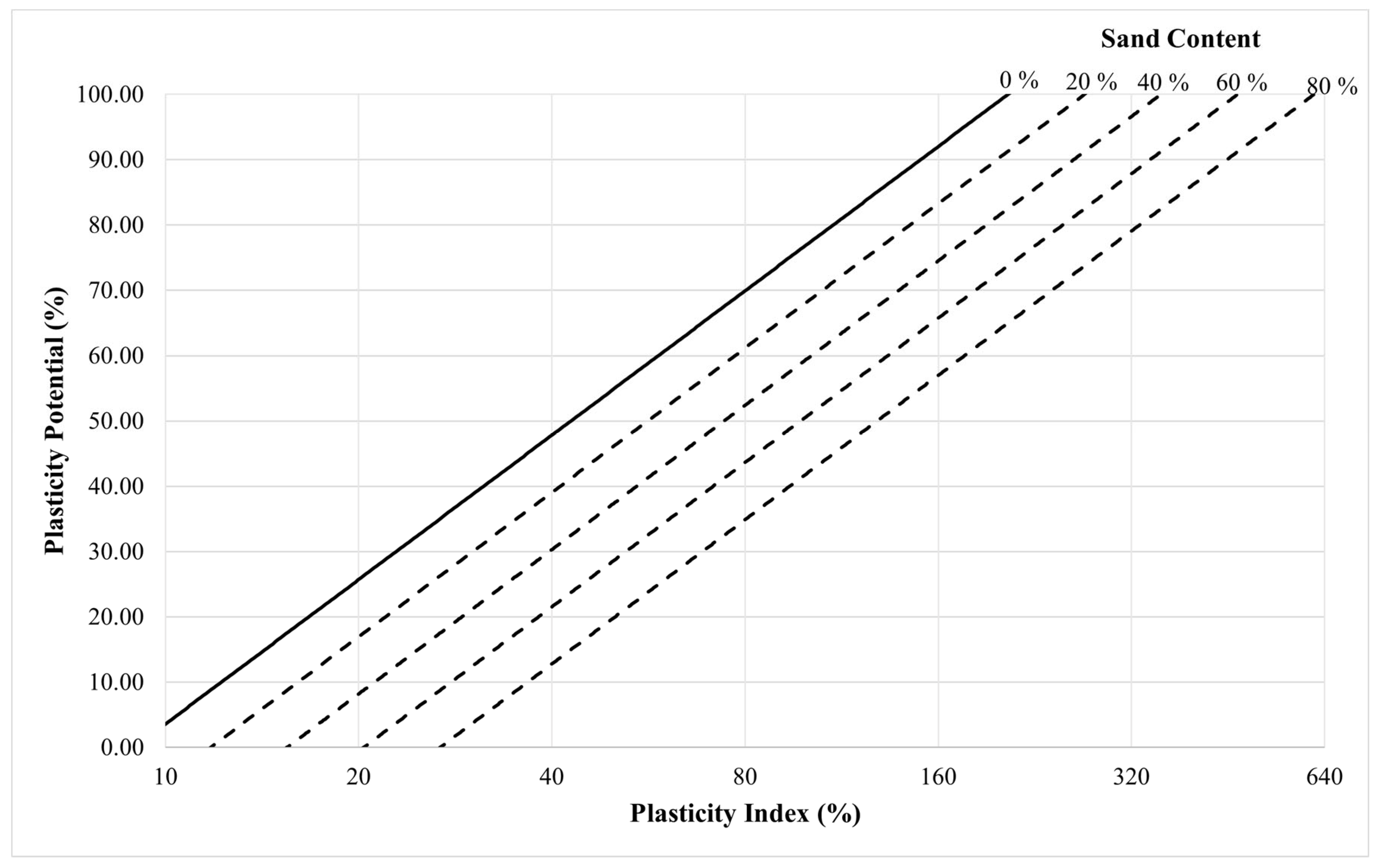5.1. Distinguishing the Plasticity Characteristics of Soils
The nature of the factor analysis assigns a factor score for each variable based on the number of factors. In this study, two factors have been extracted, therefore two distinctive factor scores were assigned to each soil. These factor scores are named as first and second-factor scores for simplicity.
These two factor scores measure the individual plasticity characteristics of each soil. The first score is the main controller of the soil plasticity since the total contribution to the analysis is 69.61% (
Table 4) and represent the effect of consistency limits, clay fraction, and montmorillonite content. The second score directly correspond to the effect of the calcium carbonate on the plasticity of each soil with a contribution of 14.53%. In this study, the factor scores were interpreted in a way such that the plasticity of soil increases with an increase in factor score and vice versa.
An intriguing way to illustrate the factor scores can be achieved by using a two-dimensional cartesian coordinate system. If the first and second, factor scores are plotted in x- and y-axes, a data scatter of the scores’ can be achieved. This kind of scatter can be easily gathered by using any statistical software. However, the interpretation of such plots can be sophisticated and generally requires a dedicated research perspective.
The first and second factor scores can be seen as a scatter plot in
Figure 5. The vertical- and horizontal-axes represent the first and second factor scores, respectively. An added simplification is performed by assigning colours to each soil based on USCS. This colourizing of soil groups vastly clarified the data scatter. A first look into the figure indicates a grouping of soils to some degree. However, this grouping is only valid for CL and MH types of soils. This confirms a valuable conclusion for CL and MH soils that they have a discrete character in terms of soil plasticity. In consequence, one should expect a rather different plastic behaviour under certain circumstances.
Low plasticity clayey soils (CL) are all on the negative side of the first factor score. Since the first factor score contributed the most to the soil problematicity, it is clearly observable that CL soils are generally less problematic than the CH and MH soils. However, this is a generalized outcome, and it is clearly visible that some CH soils also have the same problematicity as CL soils.
Contrarily, almost all the medium–high plasticity silty clayey soils (MH) are on the positive side of the first factor score and the negative side on the second factor score. This indicates that the plasticity-based characteristics of MH soils are distinctively different and yield more problems than CL soils. Also, it is clearly visible that the calcium carbonate, i.e., second factor score, has a profound control on the plastic behaviour of MH soils.
On the other hand, the CH soils have almost equal distribution along the scatter plot. This concludes that there is no significant soil property that controls the plastic behaviour of CH soils. Therefore, the plasticity of CH soils is rather controlled equally in a balanced way by consistency limits, clay fraction, and mineralogy.
5.2. Measuring the Unified Plasticity Potential of Soils
In the previous sections, factor analysis was performed on the data for various purposes. One of the first aims was to reduce the soil properties from five to two and finding the hidden interrelations between them, such as uncovering the negative effect of calcium carbonate on soil plasticity. Lastly, two different factor scores were assigned to each soil based on the regression approach. These factor scores were then analysed to distinguish the plasticity characteristics, and possibly the behaviour, of CL, CH, and MH soils.
The next part of this study is to create an empirical approach to quantitively measure the plasticity characteristics of clayey soils. Considering each factor score is a measurement of the soil plasticity, they can be used in a way to accomplish this purpose. One of the most convenient ways is to simply sum the first and second scores to have a final value that represents each soil. Considering each factor score has a different contribution to soil plasticity, this kind of direct approach would not be representative. In this study, the contribution of each factor score has been taken into account and a final resultant factor score was calculated by using a weighted summation approach. Creating a resultant factor score is the initial step to measure the plasticity potential of each soil. The equation below shows the calculation of the resultant value (Equation (3)).
Here,
is the resultant factor score,
represents the first factor score and
is the second factor score. Although the above expression yields a weighted score for each soil, it is still a non-standardized way to represent each soil. Also, the value of
can vary between negative and positive numbers, which is eventually difficult to interpret. Therefore, a standardized approach was chosen in this study. The standardization of the resultant factor score should be conducted in a range that any soil assigned with a value can be easily distinguished. Therefore, the
is standardized between 0 and 100 by considering the minimum and maximum values of the resultant factor score assigned to the soils (Equation (4)).
Here, the standardized is the plasticity potential of soils. This expression assigns a particular value between 0 and 100 to each soil. As this value increases, soil plasticity also increases. Therefore, the soil with the least plasticity potential should yield zero, and the soil that shows the most plasticity should be assigned 100.
The validation of this model is critical for the purpose of this research. Considering the plasticity index is a direct approach for measuring plasticity and is widely accepted in practice, this model should coincide if the soils are ranked based on only using the PI. Meaning that if the PI increases, the plasticity potential should also increase in a parallel way. However, the theory of this study is clear; the PI measures the plasticity but does not incorporate the effect of other soil properties. That is the reason that other soil properties related to PI, but not PI itself, were included in the analysis and eventually reduced to a standardized definition of soil plasticity. These facts should be clearly observed in order to validate the theory. Therefore, all the soils were ranked based on the plasticity potential from top-to-bottom and bottom-to-top order. This study’s ranking is then compared to the PI ranking for validation.
Table 5 and
Table 6 represent the most and the least plastic soils based on these rankings, respectively. Also, each row indicates individual soils and shows the consistency limits, clay fraction, calcium carbonate, and montmorillonite content.
An inspection of
Table 5 and
Table 6 directly reveals that there is a strong parallel relation between the PI-based ranking and this study’s ranking. Considering the top 10 soils, there is a very slight difference in ranking on most of the soils, only the sixth and eighth soils show a reasonable difference. The reason for this disparity is related to the considerably lower plasticity index of the sixth and eighth soils. However, careful examination of the factor analysis shows that the standardized score, i.e., plasticity potential, was calculated by assuming the consistency limits, clay fraction and montmorillonite content contribute to the plasticity of soils almost equally. This conclusion can be seen by examining the factor score coefficients in
Appendix A. Examination of the least potentially plastic soils (
Table 6) also coincides with the finding of the most potentially plastic soils. Therefore, this model can be assumed to work in a wide range of soil plasticity.
The above-mentioned facts justify that a quantitative model can be formulated to measure the plasticity potential of soils. Presently, the finding is very definite: the standardized score is the plasticity potential of soils that can be assigned from 0 to 100. If this model is formulated, then one could assess the plasticity potential of any soil easily. However, there should be a reliable way to predict this plasticity potential. For this purpose, some soil parameters that are easy to derive that represent different properties of the soil should be used. Considering the liquid and plastic limits, clay fraction, montmorillonite and calcium carbonate content were already used in the analysis. Therefore, if these soil properties are used for the prediction, then there will be an overlapping measure within the model. Which invalidates the whole theory. However, the plasticity index itself was not an input parameter in the analysis, therefore the PI is one of the soil properties that can be used in a way to predict the soil plasticity potential.
Figure 6 shows the relationship between this model and PI. The relationship between this model and PI yielded a very strong correlation coefficient of 0.908. This indicates the PI can be confidently used to predict the unified plasticity potential of the soils. The elemental aspect of using this model instead of PI alone is that in this study the plasticity potential of soils was measured by five different soil properties. However, the PI alone is rather a sole parameter. Therefore, using the PI to predict this study’s plasticity model allows the user to evaluate the soil plasticity in a more refined and realistic way. Therefore, using this model should represent a much more accurate way of soil plasticity. In fact, one can assume that this model is a modified plasticity index to some degree. Also, the plasticity potential is formulated as a logarithmic function of the plasticity index as shown in the equation below.
The other soil property that can be used to assess the plasticity potential is the sand content. However, sand particles themselves do not contribute to soil plasticity; therefore, sand content was not included in the factor analysis. Nevertheless, an increase in sand content should reduce the plasticity of soil in general. The reason for that is highly connected to the ratio of cohesive and noncohesive materials in the soil. Thus, a decrease in sand content tends to increase the fine content which can contribute to soil plasticity. This fact is proven by demonstrating the relationship between the plasticity potential model in
Figure 7. It is clearly observable that a decrease in sand content increases the plasticity of the soil. The most reasonable way of expressing this relation was found as a linear function yielding a coefficient of correlation of 0.704. The direct relationship between the PI and sand content was also measured which generated a coefficient of 0.519 for the same function type. This noticeable difference indicates the relationship between sand content and plasticity potential is increased by 36%. This outcome demonstrates that unifying the soil properties into one explaining model improves and even uncovers the theoretical relationships. In this circumstance, the linear function was found representative of the relation between plasticity potential and sand content (Equation (6)). The sand content is expressed as SC in the equation for clarity.
Since two different soil properties can be used to assess the plasticity potential, two of them should be combined into a singular expression that defines this model. This can be carried out by using regression analyses. However, regression analysis has many varieties such as using single or multiple variables in a linear function to predict the unknown quantity or a more complex version that uses nonlinear relations with many variables. The regression analysis is not the main subject of this study but rather a statistical tool therefore it will not be explained in detail. A classic nonlinear expression is given in Equation (6) for representation purposes. Where,
x and
z are the variables,
a and
b are the parameter estimates, and
c is the constant of the equation. This formula is a typical representation of a nonlinear relationship which includes more than one function type.
All things considered, nonlinear regression is one of the most complex regression types that require the user to decide the types of functions and the presence of constants. In this study, the relationship of PI and sand content with plasticity potential is both nonlinear and linear, therefore it is logical to adopt an overall nonlinear function for best-fitting purposes. Considering, the relationship of PI and sand content with plasticity potential was individually defined by logarithmic and linear functions, respectively. The nonlinear regression model should also be assigned in that way. Also, the parameter’s estimate and a constant were included in the regression. Therefore, the below expression was run to predict the best-suited equation of plasticity potential (Equation (8)).
Here,
y is the plasticity potential,
x is the plasticity index,
z is the sand content,
a and
b are the parameter’s estimates, and
c is the constant of the function. Considering the above equation, the nonlinear regression model was tested and found to be best suited as the following expression (Equation (9)). This relationship of PI and sand content to plasticity potential yielded a very high coefficient of correlation of 0.944. This high value of the coefficient proves that Equation (9) has an undeniable statistical significancy to represent the plasticity potential of soils in a unified form.
Considering Equation (9), which includes two different soil properties, Equations (5) and (6) should not be used to determine the exact value of the plasticity potential. Rather, the interested user should only utilize Equation (9) to define the unified plasticity potential of soils. Equation (9) works with a minimum plasticity index of 9%, thus the user should assign the plasticity potential as zero for lesser values of PI. In this sense, if any outcome is negative or greater than 100, then the plasticity potential should be assigned as 0 and 100, respectively.
Also, the authors proposed to the interested user to use the following figures for quick assessment. In this case,
Figure 8 is best suited for greater values of the plasticity index and
Figure 9 for lesser values. Additionally, the extent of this study includes sand content between 0 and 50 percent. Therefore,
Figure 8 and
Figure 9 have been created by extrapolating the sand content up to 80%. The 60 and 80% lines are theoretical and should be used cautiously. Especially, where sand content exceeds 50% with very high plasticity index, above 150%, this model should be a rough guidance concerning the soil plasticity potential rather than assigning a definitive value.
The factor analysis was carried out after transforming the soil properties to normal distribution. Based on this fact, the plasticity potential between 0 and 100 was also assigned to the soils as normally distributed. This distribution can be used to categorize the plasticity potential statistically. For this purpose, the three-sigma rule also as known as the 68-95-99.7 rule was applied to the data [
73]. This rule allows the researcher to categorize the data in percentages based on certain intervals, if the data are normally distributed. These certain percentages are 2.35, 15.85, 49.85, 83.85, and 97.85 and correspond to the plasticity potential of 5.4, 27.5, 48.7, 70.0, and 85.6, respectively. To avoid any confusion, the percent of 15.85 corresponds to a plasticity potential from 0 to 27.5.
Based on this approach, the plasticity potential is divided into six categories starting from negligible to severe plasticity, as shown in
Table 7. A generalized indication of these categories is also represented in terms of effective angle of internal friction
, undrained shear strength (
, compressibility while compacted and saturated and volume change potential upon wetting and drying. These positive and negative relationships of plasticity potential between material properties are a generalized derivation from the literature [
74,
75,
76,
77,
78,
79]. Considering there is a positive logarithmic relation between PI and plasticity potential, a drastic increase in PI should also increase the plasticity potential. The exact relations can be formulized by extensive laboratory work, which is out of the scope of this study. Although this model allows the user to easily access the desired range of plasticity potential, he/she should be aware of the appropriate material selection based on the project or research needs.
